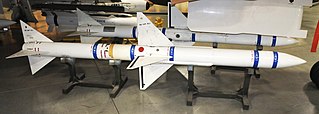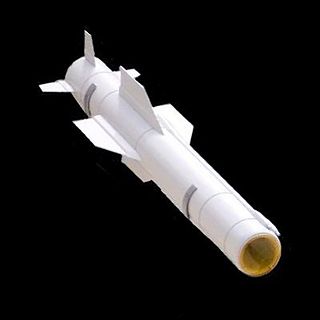 W
WThe AGM-65 Maverick is an air-to-ground missile (AGM) designed for close air support. It is the most widely produced precision-guided missile in the Western world, and is effective against a wide range of tactical targets, including armor, air defenses, ships, ground transportation and fuel storage facilities.
 W
WThe AGM-114 Hellfire is an air-to-surface missile (ASM) first developed for anti-armor use, but later models were developed for precision drone strikes against other target types, and have been used in a number of actions aimed to "destroy high-value targets." It was originally developed under the name Heliborne laser, fire-and-forget missile, which led to the colloquial name "Hellfire" ultimately becoming the missile's formal name. It has multi-mission, multi-target precision-strike ability, and can be launched from multiple air, sea, and ground platforms, including the Predator drone. The Hellfire missile is the primary 100-pound (45 kg) class air-to-ground precision weapon for the armed forces of the United States and many other nations. It has also been fielded on surface platforms in the surface-to-surface and surface-to-air roles.
 W
WThe AIM-7 Sparrow is an American, medium-range semi-active radar homing air-to-air missile operated by the United States Air Force, United States Navy, and United States Marine Corps, as well as other various air forces and navies. Sparrow and its derivatives were the West's principal beyond visual range (BVR) air-to-air missile from the late 1950s until the 1990s. It remains in service, although it is being phased out in aviation applications in favor of the more advanced AIM-120 AMRAAM.
 W
WThe AIM-9 Sidewinder is a short-range air-to-air missile which entered service with the US Navy in 1956 and subsequently was adopted by the US Air Force in 1964. Since then the Sidewinder has proved to be an enduring international success, and its latest variants are still standard equipment in most western-aligned air forces. The Soviet K-13, a reverse-engineered copy of the AIM-9, was also widely adopted by a number of nations.
 W
WThe AIM-120 Advanced Medium-Range Air-to-Air Missile, or AMRAAM, is an American beyond-visual-range air-to-air missile (BVRAAM) capable of all-weather day-and-night operations. Designed with a 7-inch (180mm) diameter form-and-fit factor, and employing active transmit-receive radar guidance instead of semi-active receive-only radar guidance, it has the advantage of being a fire-and-forget weapon when compared to the previous generation Sparrow missiles. When an AMRAAM missile is launched, NATO pilots use the brevity code Fox Three.
 W
WBrimstone is a ground or air-launched ground attack missile developed by MBDA UK for Britain's Royal Air Force. It was originally intended for "fire-and-forget" use against mass formations of enemy armour, using a millimetric wave (mmW) active radar homing seeker to ensure accuracy even against moving targets. Experience in Afghanistan led to the addition of laser guidance in the dual-mode Brimstone missile, allowing a "spotter" to pick out specific and the highest priority targets, particularly useful to minimise collateral damage when friendly forces or civilians were in the area. The tandem shaped charge warhead is much more effective against modern tanks than older similar weapons such as the AGM-65G Maverick, while the small blast area minimises collateral damage. Three Brimstones are carried on a launcher that occupies a single weapon station, allowing a single aircraft to carry many missiles.
 W
WThe de Havilland Firestreak is a British first-generation, passive infrared homing air-to-air missile. It was developed by de Havilland Propellers in the early 1950s and was the first such weapon to enter active service with the Royal Air Force (RAF) and Fleet Air Arm, equipping the English Electric Lightning, de Havilland Sea Vixen and Gloster Javelin. It was a rear-aspect, fire and forget pursuit weapon, with a field of attack of 20 degrees either side of the target.
 W
WThe FGM-148 Javelin is an American man-portable fire-and-forget anti-tank missile fielded to replace the M47 Dragon anti-tank missile in US service. It uses automatic infrared guidance that allows the user to seek cover immediately after launch, as opposed to wire-guided systems, like the Dragon, which require the user to guide the weapon throughout the engagement. The Javelin's HEAT warhead is capable of defeating modern tanks by hitting them from above where their armor is thinnest, and is also useful against fortifications in a direct attack flight. As of January 2019, over 5,000 Javelin missiles have been fired in combat.
 W
WThe FGM-172 SRAW, also known as the Predator SRAW, was a lightweight, close range missile system produced by Lockheed Martin, developed by Lockheed Martin and Israel Military Industries. It was designed to complement the Javelin anti-tank missile. The Predator had a longer range and was more powerful than the AT4 that it was designed to replace, but had a shorter range than the Javelin.
 W
WThe Harpoon is an all-weather, over-the-horizon, anti-ship missile, developed and manufactured by McDonnell Douglas. The Standoff Land Attack Missile (SLAM) is a land-attack variant.
 W
WHermes is a family of modularly-designed guided missiles developed in Russia by the KBP Instrument Design Bureau.
 W
WThe Hongjian-12 is a third generation, man-portable, fire-and-forget infrared homing anti-tank missile of China. It was unveiled at the Eurosatory 2014 exhibition.
 W
WHJ-10 is a Chinese ground-launched anti-tank missile developed by Norinco. It has a tandem high-explosive anti-tank (HEAT) warhead, that may penetrate 1,400 mm (55 in) of conventional steel armour protected by explosive reactive armour. The maximum range is 10 km (6.2 mi), with pre- or post-launch lock-on. Air-launched variants for helicopters and drones have also been developed.
 W
WThe Kh-59 Ovod is a Russian TV-guided cruise missile with a two-stage solid-fuel propulsion system and 200 km range. The Kh-59M Ovod-M is a variant with a bigger warhead and turbojet engine. It is primarily a land-attack missile but the Kh-59MK variant targets ships.
 W
WThe MBDA MICA is an anti-air multi-target, all weather, fire-and-forget short and medium-range missile system. It is intended for use both by air platforms as individual missiles as well as ground units and ships, which can be equipped with the rapid fire MICA Vertical Launch System. It is fitted with a thrust vector control (TVC) system. It was developed from 1982 onward by Matra. The first trials occurred in 1991, and the missile was commissioned in 1996 to equip the Rafale and Mirage 2000. It is a replacement for both the Super 530 in the interception role and the Magic II in the dogfighting role.
 W
WMissile Moyenne Portée is a French man-portable anti-tank guided missile. It was developed by MBDA Missile Systems and is intended as a replacement for their MILAN, which has been sold worldwide.
 W
WThe Nag missile, also called "Prospina" for the land-attack version, is an Indian third-generation, all-weather, fire-and-forget, lock-on after launch, anti-tank guided missile (ATGM) with an operational range of 500 m to 20 km. It has a single-shot hit probability of 90% and a ten-year, maintenance-free shelf life. The Nag has five variants under development: a land version, for a mast-mounted system; the helicopter-launched Nag (HELINA) also known as Dhruvastra; a "man-portable" version (MPATGM); an air-launched version which will replace the current imaging infra-red (IIR) to millimetric-wave (mmW) active radar homing seeker; and the Nag Missile Carrier (NAMICA) "tank buster", which is a modified BMP-2 Infantry Fighting Vehicle (IFV) produced under license in India by Ordnance Factory Medak (OFMK).
 W
WThe P-800 Oniks, also known in export markets as Yakhont, is a Soviet / Russian supersonic anti-ship cruise missile developed by NPO Mashinostroyeniya as a ramjet version of P-80 Zubr. Its GRAU designation is 3M55, the air launched Kh-61 variant also exists. The missile has the NATO codename SS-N-26 "Strobile". Development officially started in 1983, and in the 1990s the anti-ship missile was tested on the Project 1234.7 ship. In 2002 the missile passed the whole range of trials and was commissioned. It is reportedly a replacement of the P-270 Moskit, but possibly also of the P-700 Granit. The P-800 was used as the basis for the joint Russian-Indian supersonic missile BrahMos.
 W
WThe PARS 3 LR in German service, also known as TRIGAT-LR and AC 3G in French, is a fire-and-forget missile, which can be used against air or ground targets. It is intended for long range applications and designed to defeat tanks, helicopters and other individual targets, while minimizing the exposure of the launch vehicle to enemy fire. It is to be the main weapon system of the Eurocopter Tiger UHT helicopter. PARS 3 LR will be able to be fired in salvos of up to four in eight seconds. The missile can be applied in direct attack or top-attack modes. It was in development as of 2011.
 W
WThe Vympel NPO R-77 missile is a Russian active radar homing beyond-visual-range air-to-air missile. It is also known by its export designation RVV-AE. It is the Russian counterpart to the American AIM-120 AMRAAM missile.
 W
WThe RBS-15 is a long-range fire-and-forget surface-to-surface and air-to-surface anti-ship missile. The later version Mk. III has the ability to attack land targets as well. The missile was developed by the Swedish company Saab Bofors Dynamics.
 W
WProject Sense and Destroy ARMor, or SADARM, is a United States 'smart' submunition capable of searching for, and destroying tanks within a given target area.
 W
WThe Shershen is a Belarusian third generation anti-tank guided missile (ATGM), based on Ukrainian ATGM Skif but reportedly with additional capabilities. Designed to defeat modern armored vehicles, protected objects and low-speed low-altitude targets.
 W
WThe Skif is a Ukrainian anti-tank guided missile (ATGM) system developed by the Luch Design Bureau. Its guidance device (ПН-С) is developed and manufactured by Belarusian design bureau Peleng based in Minsk. The name literally means "Scythian".
 W
WThe "SPICE" is an Israeli-developed, EO/GPS-guided guidance kit for converting air-droppable unguided bombs into precision guided bombs.
 W
WSpike is an Israeli fire-and-forget anti-tank guided missile and anti-personnel missile with a tandem-charge HEAT warhead, currently in its fourth-generation. It was developed and designed by the Israeli company Rafael Advanced Defense Systems. It is available in man-portable, vehicle-launched, and helicopter-launched variants.
 W
WThe Type 01 LMAT is a Japanese man-portable fire-and-forget anti-tank missile. Development began in 1993 at Kawasaki Heavy Industries and was accepted into service in 2001. During development, the missile was designated with the codename XATM-5. It was later known shortly as the ATM-5.
 W
WUMTAS or Mizrak-U (Uzun Menzilli Tanksavar Sistemi) is a modern long range air-to-surface anti-tank missile developed by Turkish armor and missile manufacturer ROKETSAN.